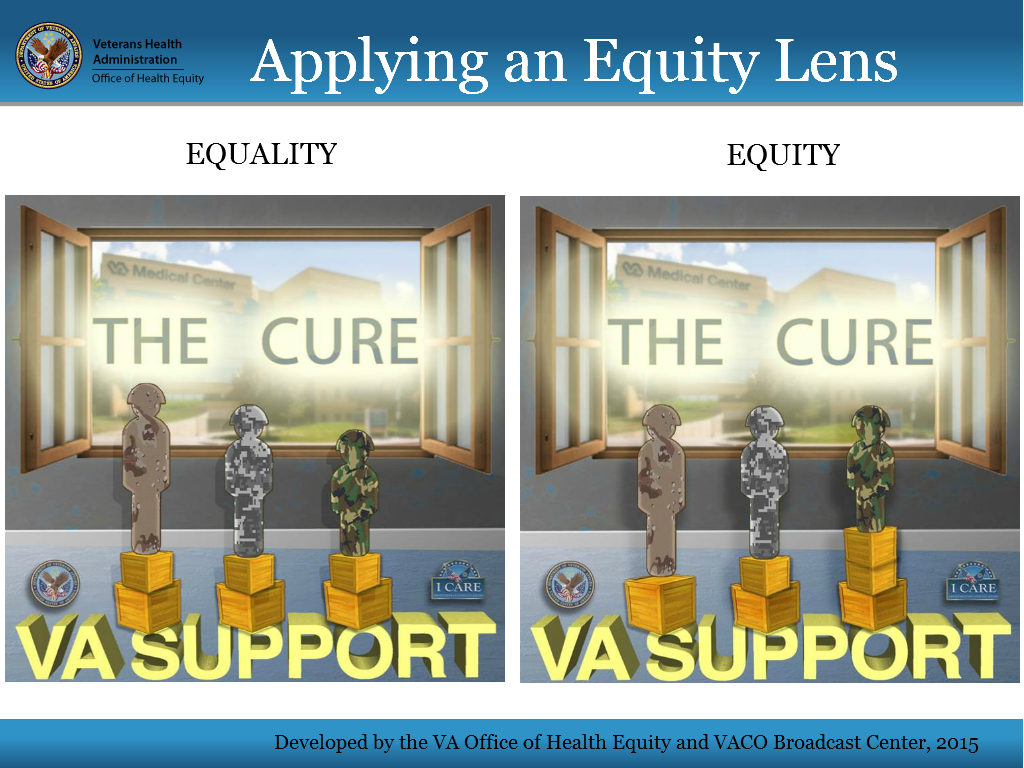Applying an Equity Lens
The Difference between Equality and Equity—Part 1
Many people incorrectly use equality and equity in their conversations by believing that these concepts have the same meaning. This confusion even makes its way into treatment approaches in medical establishments and decision making. The meanings of equality and equity are different. While subtle, these can determine which resources people receive in society and how these resources are allocated. For Veterans particularly, selecting an approach to improve Veteran’s care from an equality standpoint versus an equity standpoint determines the level of care or support a Veteran receives, the Veteran’s well-being, and whether the Veteran achieves optimal health.
A quick search of the internet can provide various definitions for equality and equity; the subtle and important differences in these concepts; and depictions to help the most novice person distinguish between equality and equity. For the last point, the Office of Health Equity developed the Applying an Equity Lens depiction based on similar renderings. Our goal is to be Veteran-centric in order to champion and raise awareness of health equity issues among Veterans, VHA staff, and stakeholders.
The Applying an Equity Lens depiction shows two panels. In each, Veterans/Service Members of different heights look out through an open window. A VA medical center (VAMC) is outside of that window. Beyond that window, at the VAMC, is an opportunity, a cure, or at the very least some relief to a health concern. Each Veteran/Service Member in the panels stands on bins that are supported by various types of VA interventions to improve care that minimally include, or should include, the strategic goals outlined by the VHA and access to care.
The panel on the left shows each Veteran/Service Member standing on two bins. The Veteran/Service Member to the left, the tallest one of the three, has a clear view out of the window of the cure while the Veteran/Service Member to the far right, the shortest of the three, has an obstructed view of the cure. The Veteran/Service Member is barely able to see out the window or believe that relief is possible. This is an example of equality. All Veterans/Service Members receive the same number of bins or types of VA treatment, support, resources, etc.
Now look at the panel on the right. Do you see differences between the two? You are correct if you notice the number of bins differing for each Veteran/Service Member. Regardless of height, each Veteran/Service Member is given the needed number of bins to stand on in order to have an unobstructed view out of the window. Each can see the same opportunity for optimal health. The Veteran/Service Member on the left has been given one bin, the Veteran/Service Member in the middle has been given two bins, and the Veteran/Service Member on the right has been given three bins. This is fair and this is an example of equity. In this depiction, everyone gets a box for starters and the Veterans/Service Members who are not as tall get additional boxes in order to ensure everyone has the same opportunity.
Vulnerable Veterans may experience differences in their health and healthcare. These differences are known as a health disparity if the difference is linked to or associated with social or economic disadvantages. In other words, health disparities adversely affect groups of people who have systematically experienced greater social and/or economic obstacles to health and/or a clean environment based on their racial or ethnic group; gender; age; geographic location; religion; socio-economic status; sexual orientation; mental health; military era or period served; cognitive, sensory, or physical disability; or other characteristics historically linked to discrimination or exclusion.
Applying an equity lens to the care of vulnerable Veterans at the VHA and beyond requires treatment, interventions, and other types of support to ensure that all Veterans have the same opportunity for optimal health. Please visit www.va.gov/healthequity to learn more about Veterans health equity. There you will find the VHA Health Equity Action Plan that provides a strategic roadmap for the VHA, Veterans, and stakeholders to ensure all Veterans receive equitable care.
Stay tuned for Part 2 of this series as it will address what you can do in your area of influence, or encourages others, so that all Veterans receive equitable care and health disparities are eliminated.




















